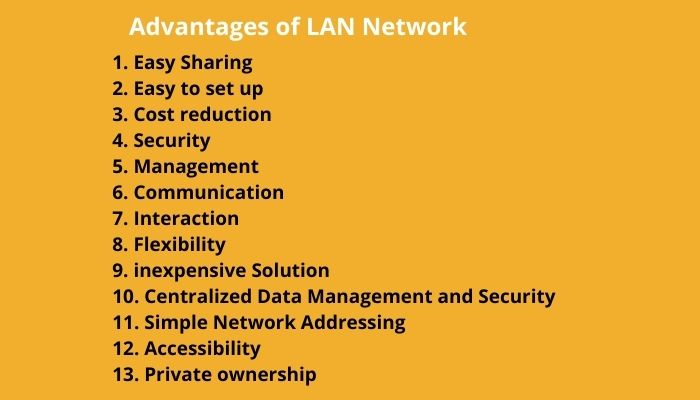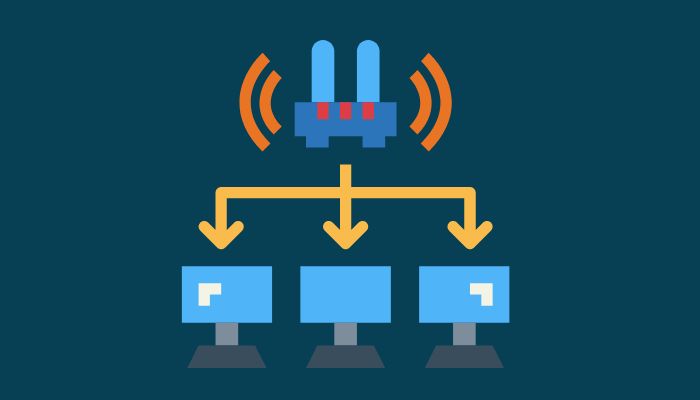LAN stands for Local Area Network and is a computer network that spans a limited area from 100-1000 meters. This range does not include the internet. LAN is often used to connect computers in an office or home for any type of data transfer, such as computers sharing printers, a server, or other resources.
The advantages of LAN networks enable users to access a common data resource simultaneously, share programs or files, and help each other. All these create an environment of mutual trust and cooperation.
what is the purpose of LAN?
- LAN can be used for communication, to ensure the transmission of messages in the shortest time and reduce delays.
- LAN can expand the scope of data transport by connecting different networks.
- LAN can be used for sharing resources, such as files, printers, databases, and other kinds of electronic equipment or special devices.
- LAN can be used to increase the efficiency of information processing and management.
13 Advantages of LAN Network
Local Area Network Technology has various advantages like the advantages of computer networking in business, education, and other aspects related to the use of computers. Some of the most important benefits of LAN are given here. Let’s have a look:

1. Easy Sharing
The main benefit of LAN technology is the ease of sharing. For example, one person can click the “print” icon on his computer and instantly send a document or an image to another computer on the LAN and all in one step.
By using this method, computer users can share programs, data files, or resources via a simple process. This can also be applied to other types of data such as images or voice clips.
2. Easy to set up
Whether you are setting up a small network for your home or connecting several different locations in an office, LAN is easy to set up. You won’t need to invest heavily in setting up a network system because the technology has been tested and proven over the years.
3. Cost reduction
LAN can save you money because they allow people to share a printer, a scanner, and other peripherals. For large offices, it is common to have laser printers, which can cost hundreds of dollars each.
However, by making the device available throughout the office through the network, you can reduce costs significantly. A laser printer also requires a lot of power and paper, so by having central access you can use it as sparingly as possible and minimize waste.
4. Security
The LAN is a secure network that has fewer chances of being hacked or damaged. Its speed and performance are also improved so that it can keep up with the needs of the growing business environment.
Another advantage is that it can also be broken into several small networks as per the requirement so there will be no threat to security when internal networks work together.
5. Management
The LAN network also helps in managing the business efficiently. It provides a way to give the employees access to the information that they require. It proves to be an effective tool for sharing data between the head office and its different branches.
6. Communication
The LAN is used to give business communication on a global level. This way, it becomes easier for the employees to work together across different locations instead of depending on one single access point.
7. Interaction
The faster communication and efficient sharing of information make the employees feel more comfortable in their work and give them the feeling that they are working together as a team.
8. Flexibility
The LAN can be organized in a way that speed and performance increase productivity. It will also help in saving costs by reducing printing, storing, and sending of documents. It also reduces the amount of paper that is wasted and improves communication efficiency.
9. inexpensive Solution
It is an inexpensive solution compared to other types of networks. LAN technology is simple, fast, and easy to implement.
It doesn’t require a lot of time for its integration into any environment or business organization. Thus, it can be used as a reliable and cheap alternative computer network solution.
10. Centralized Data Management and Security
The main pros of all LAN technologies are that they provide centralized data management and security. It means that the data is being stored in one particular place.
LAN network users can access it through various computers that are connected to the server. This is not possible with WANs, where the data management and security are decentralized.
11. Simple Network Addressing
Local Area Network Technology provides simple network addressing. It is being used by various kinds of businesses because it has a superior addressing scheme that enables easy identification of all connected devices.
12. Accessibility
Local Area Network Technology is easy to access. It uses a simple addressing scheme and requires a small amount of hardware, which makes it inexpensive.
This is not possible with WANs, which are harder to implement in any business organization or environment.
13. Private ownership
The ownership of data can be private or public. The LAN architecture does not allow any user to access another computer in the network, such as a specific server or PC. This makes it more secure and reliable than WANs, which don’t provide this level of privacy.
FAQs
What are the types of LAN Network?
- Ethernet LAN
- Token Ring LAN
- Fast Ethernet
- ATM LAN
- Fiber Distributed Data Interface (FDDI)
- Fiber optic LAN
- Wireless LAN
- WiFi
- Lightning Bolt Network (LBN)
- LocalTalk
How LAN is different from WAN?
LAN and WANs are not the same. LAN stands for Local Area Network, while WAN stands for Wide Area Network. With WAN, there is no need to go to any other computer in the network to access another machine’s files or software.
It also provides a connection between two machines or different locations. LAN is often used to connect computers in an office or home for any type of data transfer
How does LAN Network work?
LAN works via a network interface card (NIC). It is used to connect computers with each other. The NIC is installed in a computer and connected with the LAN hardware.
LAN is usually based on a topology in which every machine has its own cable that connects it with other devices.
What is the Example of LAN Network?
Example 1:
An example of LAN is a network set up between computers in an office. The network is used for sharing resources such as printers, files, and access to servers.
Example 2:
Another example of LAN is a network set up in homes. The network enables every computer to access each other’s files and hardware.
Example 3:
Yet another example of LAN is a wireless LAN, which is usually created to enable devices to connect via radio waves.
Conclusion
At the end of the day, LANs are the perfect solution for all businesses that need to share data and resources. They offer easy installation and integration, simple addressing, and advanced security measures. All of this makes it more reliable than other network technologies.
Hope this discussion is clear to you. The pros of LAN are all about. If you have any queries, you can drop a comment anytime. I will try to help you as much as possible.
Thank you!

